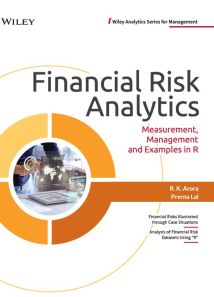Financial Risk Analytics: Measurement, Management and Examples in R
ISBN: 9789354642135
Publication Year: 2022
For more information write to us at: acadmktg@wiley.com

Description
The book is of particular use for risk managers working in the banking industry. Banks are required by the Basel guidelines to have sufficient risk capital to cover the potential losses that they face. Banks can either use the norms prescribed by the Basel guidelines or their own risk models to measure different financial risks in order to estimate the risk capital requirement. The book can be extremely helpful to banks in performing these tasks.
Praise for the Book
Preface
Features of the Book
About the Authors
Chapter 1 Role of Analytics in Risk Management
1.1 Introduction
1.2 Role of Data in Analytics
1.3 Types of Data Analytics
1.4 Use of “R” for Analytics
1.5 Challenges in Use of Data Analytics
1.6 Risk Analytics
1.7 Steps in Risk Analytics
1.8 Benefits of Risk Analytics
1.9 Financial Risk Analytics 1
1.10 Current State of Financial Risk Analytics
1.11 Future of Financial Risk Analytics
1.12 Job Role of a Financial Risk Analyst and the Required Skills
Chapter 2 Introduction To Financial Risk Management
2.1 Introduction
2.2 Risk Management
2.3 Benefits of Risk Management
2.4 Types of Risks
2.4.1 Examples of Business Risks
2.4.2 Non-business Risks
2.5 Financial Markets
2.6 Types of Financial Risks
2.7 Market Risk
2.8 Credit/Counterparty Risk
2.9 Operational Risk
2.10 Model Risk
2.11 Risk and Risk Factors
2.12 Financial Risk Management
2.13 Steps in the Risk Management Process
Part I Market Risk
Chapter 3 Sensitivity Measures of Market Risk
3.1 Introduction
3.2 Sensitivity Measures of Market Risk
Chapter 4 Volatility and Correlation Measures of Market Risk
4.1 Introduction
4.2 Estimation of Volatility
4.3 Standard Approach
4.4 Weighting Schemes
4.5 The ARCH Model
4.6 The EWMA Model
4.7 GARCH (1,1) Model
4.8 Forecasting Future Volatility for Option Pricing
4.9 Component GARCH Model
4.10 Asymmetric Volatility
4.11 Implied Volatilities
4.12 Volatility Indices
4.13 Predicting Correlations
Chapter 5 Value at Risk and Expected Shortfall
5.1 Introduction
5.2 Value at Risk
5.3 Expected Shortfall (ES)
5.4 Choice of VaR Parameters
5.5 Aggregation of VaR and ES
5.6 Calculating VaR
5.7 Parametric and Nonparametric VaR
5.8 HS Approach
5.9 Monte Carlo Simulation Approach
5.10 Parametric VaR
5.11 VaR for Non-normal Distributions
5.12 Parametric Versus Nonparametric VaR
5.13 Marginal VaR
5.14 Component VaR
5.15 Back Testing
5.16 Stress Testing
5.17 Risk Metrics
Chapter 6 Management of Market Risk
6.1 Introduction
6.2 Portfolio Diversification
6.3 Hedging
6.4 Insurance-Type Contracts
6.5 Portfolio Insurance
6.6 Internal Hedges
6.7 Basel Guidelines
Part II Credit Risk
Chapter 7 Estimating Default and Migration Probabilities
7.1 Introduction
7.2 Credit Risk VaR
7.3 Measuring Probability of Default
7.4 Migration Probabilities
7.5 Basel Guidelines
Chapter 8 Credit Value at Risk
8.1 Introduction
8.2 Exposure at Default
8.3 Loss Given Default
8.4 Credit Risk Correlations
8.5 Expected and Unexpected Loss
8.6 Credit Risk Models
Chapter 9 Management of Credit Risk
9.1 Introduction
9.2 Marking-to-Market
9.3 Netting
9.4 Collateralization
9.5 Downgrade Triggers
9.6 Loan Syndication
9.7 Guarantees and Letters of Credit
9.8 Credit Rationing
9.9 Debt Covenants
9.10 Monitoring
9.11 Put Options
9.12 Credit Derivatives
9.13 Credit Insurance
9.14 Securitization
9.15 Basel Guidelines
Part III Other Financial Risk
Chapter 10 Operational Risk
10.1 Introduction
10.2 Types of Operational Risk Losses
10.3 Measurement of Operational Risk
10.4 Managing Operational Risk
10.5 Basel Guidelines
Chapter 11 Liquidity Risk
11.1 Introduction
11.2 Types of Liquidity Risk
11.3 Funding Liquidity Risk
11.4 Managing Liquidity Risk
11.5 Liquidity Black Holes
11.6 Basel III Regulations
Chapter 12 Model Risk
12.1 Introduction
12.2 Models for Pricing Standard Products
12.3 Models for Non-standard Products
12.4 Sources of Model Risk
12.5 Quantifying Model Risk
12.6 Managing Model Risk
12.7 Regulatory Requirement
12.8 Model Development
12.9 Model Validation
Part IV Other Topics
Chapter 13 Asset Liability Management
13.1 Introduction
13.2 Objectives of ALM
13.3 Interest Rate Risk
13.4 Liquidity Funding Risk
13.5 Organization of the ALM Function
13.6 Reserve Bank of India Guidelines on ALM by Indian Banks
Chapter 14 Enterprise Risk Management
14.1 Introduction
14.2 Economic Capital
14.3 Risk Appetite
14.4 Risk Culture
14.5 Top-down Approach
14.6 Bottom-up Approach
14.7 Risk Allocation
14.8 Risk-Adjusted Performance Measurement
14.9 Risk-Based Pricing
Chapter 15 Financial Innovation
15.1 Introduction
15.2 Important Financial Innovations
15.3 Role of Finance Theories and Models in Stimulating Financial Innovation
15.4 Factors that Motivate Financial Innovation
15.5 Diffusion of Financial Innovations
15.6 Classification and Functions of the Financial Innovations
15.7 Implications of Innovations on Financial Markets
15.8 The Future of Financial Innovation
Part V Appendices
Appendix A Sovereign Risk and Financial Crisis
A.1 Introduction
A.2 Sovereign Risk
A.3 Credit Crisis 2007
A.4 Flash Crashes
Real-Life Examples
Appendix B Solvency II Guidelines
B.1 Introduction
B.2 Objectives of Solvency II
B.3 Applicability
B.4 Pillars
Appendix C Introduction to Probability Theory
C.1 Probability
C.2 Properties of Probability
C.3 Characteristics of Probability Distributions
Appendix D Introduction to Financial Derivatives
D.1 Derivative
D.2 Types of Derivative Contracts
D.3 Put-Call Parity Theorem
Index

